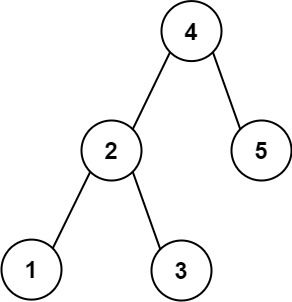Welcome to Subscribe On Youtube
272. Closest Binary Search Tree Value II
Description
Given the root of a binary search tree, a target value, and an integer k, return the k values in the BST that are closest to the target. You may return the answer in any order.
You are guaranteed to have only one unique set of k values in the BST that are closest to the target.
Example 1:

Input: root = [4,2,5,1,3], target = 3.714286, k = 2 Output: [4,3]
Example 2:
Input: root = [1], target = 0.000000, k = 1 Output: [1]
Constraints:
- The number of nodes in the tree is
n. 1 <= k <= n <= 104.0 <= Node.val <= 109-109 <= target <= 109
Follow up: Assume that the BST is balanced. Could you solve it in less than O(n) runtime (where n = total nodes)?
Solutions
A pair of difference diff and node value stored in the heap.
In order to traverse the binary tree (other traversal methods can also be used), and then calculate the absolute value of the difference between the target value and the target value for each node value.
Due to the nature of the maximum heap, the largest diff is automatically the first to maintain k pairs, if If there are more than k, delete the big pair at the front of the heap, and remove the node value in the pair for the k pairs left and store it in the result.
-
/** * Definition for a binary tree node. * public class TreeNode { * int val; * TreeNode left; * TreeNode right; * TreeNode() {} * TreeNode(int val) { this.val = val; } * TreeNode(int val, TreeNode left, TreeNode right) { * this.val = val; * this.left = left; * this.right = right; * } * } */ class Solution { private List<Integer> ans; private double target; private int k; public List<Integer> closestKValues(TreeNode root, double target, int k) { ans = new LinkedList<>(); this.target = target; this.k = k; dfs(root); return ans; } private void dfs(TreeNode root) { if (root == null) { return; } dfs(root.left); if (ans.size() < k) { ans.add(root.val); } else { if (Math.abs(root.val - target) >= Math.abs(ans.get(0) - target)) { return; } ans.remove(0); ans.add(root.val); } dfs(root.right); } } -
/** * Definition for a binary tree node. * struct TreeNode { * int val; * TreeNode *left; * TreeNode *right; * TreeNode() : val(0), left(nullptr), right(nullptr) {} * TreeNode(int x) : val(x), left(nullptr), right(nullptr) {} * TreeNode(int x, TreeNode *left, TreeNode *right) : val(x), left(left), right(right) {} * }; */ class Solution { public: queue<int> q; double target; int k; vector<int> closestKValues(TreeNode* root, double target, int k) { this->target = target; this->k = k; dfs(root); vector<int> ans; while (!q.empty()) { ans.push_back(q.front()); q.pop(); } return ans; } void dfs(TreeNode* root) { if (!root) return; dfs(root->left); if (q.size() < k) q.push(root->val); else { if (abs(root->val - target) >= abs(q.front() - target)) return; q.pop(); q.push(root->val); } dfs(root->right); } }; -
# Definition for a binary tree node. # class TreeNode: # def __init__(self, val=0, left=None, right=None): # self.val = val # self.left = left # self.right = right class Solution: def closestKValues(self, root: TreeNode, target: float, k: int) -> List[int]: def dfs(root): if root is None: return dfs(root.left) if len(q) < k: q.append(root.val) else: if abs(root.val - target) >= abs(q[0] - target): return q.popleft() q.append(root.val) dfs(root.right) q = deque() dfs(root) return list(q) ############# from collections import deque # iteration class Solution: def closestKValues(self, root: TreeNode, target: float, k: int) -> List[int]: stack = [] q = deque() # Iterative in-order traversal while stack or root: while root: stack.append(root) root = root.left root = stack.pop() # Process current node if len(q) < k: q.append(root.val) else: if abs(root.val - target) < abs(q[0] - target): q.popleft() q.append(root.val) else: break # Early stop if the current value is farther than the first value in queue root = root.right return list(q) -
/** * Definition for a binary tree node. * type TreeNode struct { * Val int * Left *TreeNode * Right *TreeNode * } */ func closestKValues(root *TreeNode, target float64, k int) []int { var ans []int var dfs func(root *TreeNode) dfs = func(root *TreeNode) { if root == nil { return } dfs(root.Left) if len(ans) < k { ans = append(ans, root.Val) } else { if math.Abs(float64(root.Val)-target) >= math.Abs(float64(ans[0])-target) { return } ans = ans[1:] ans = append(ans, root.Val) } dfs(root.Right) } dfs(root) return ans }